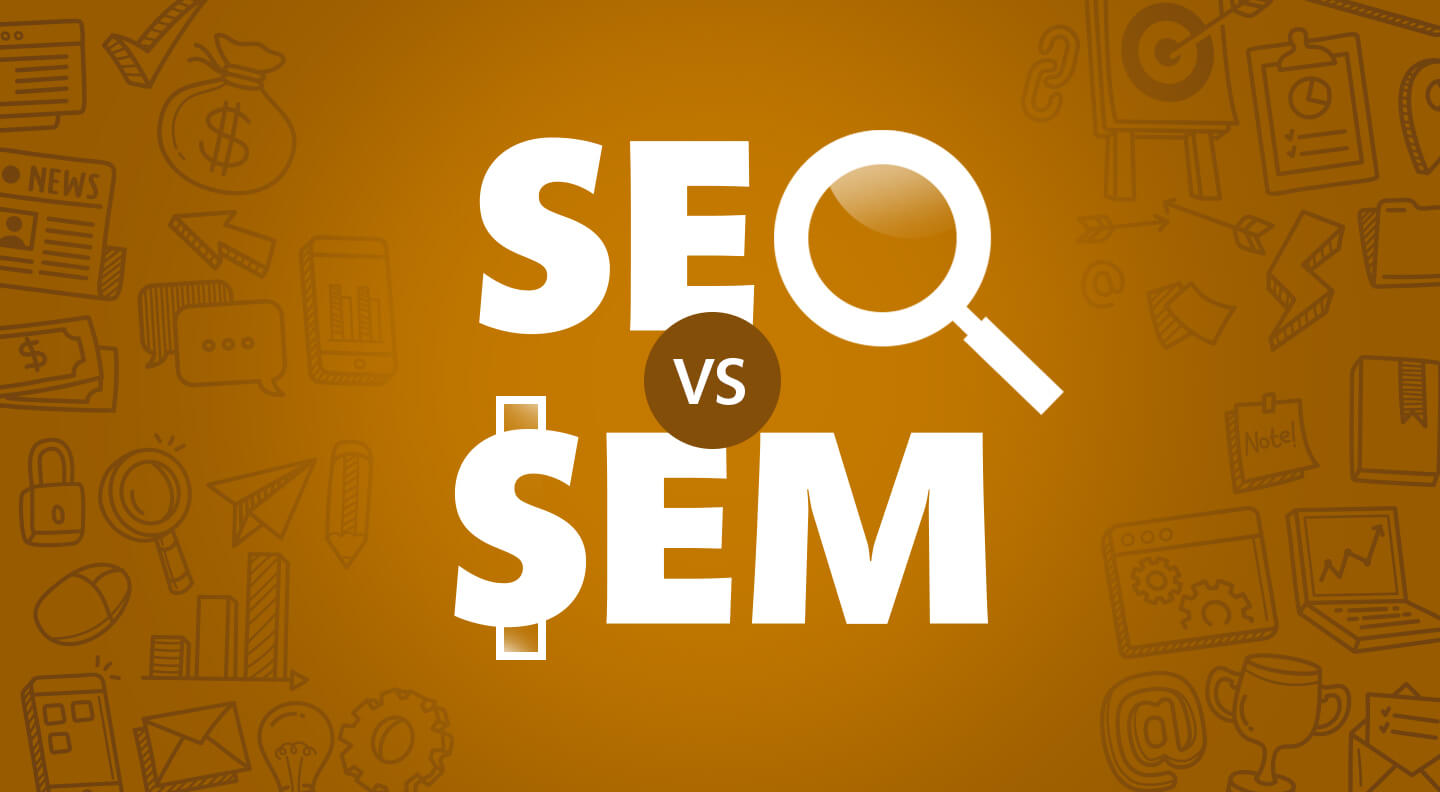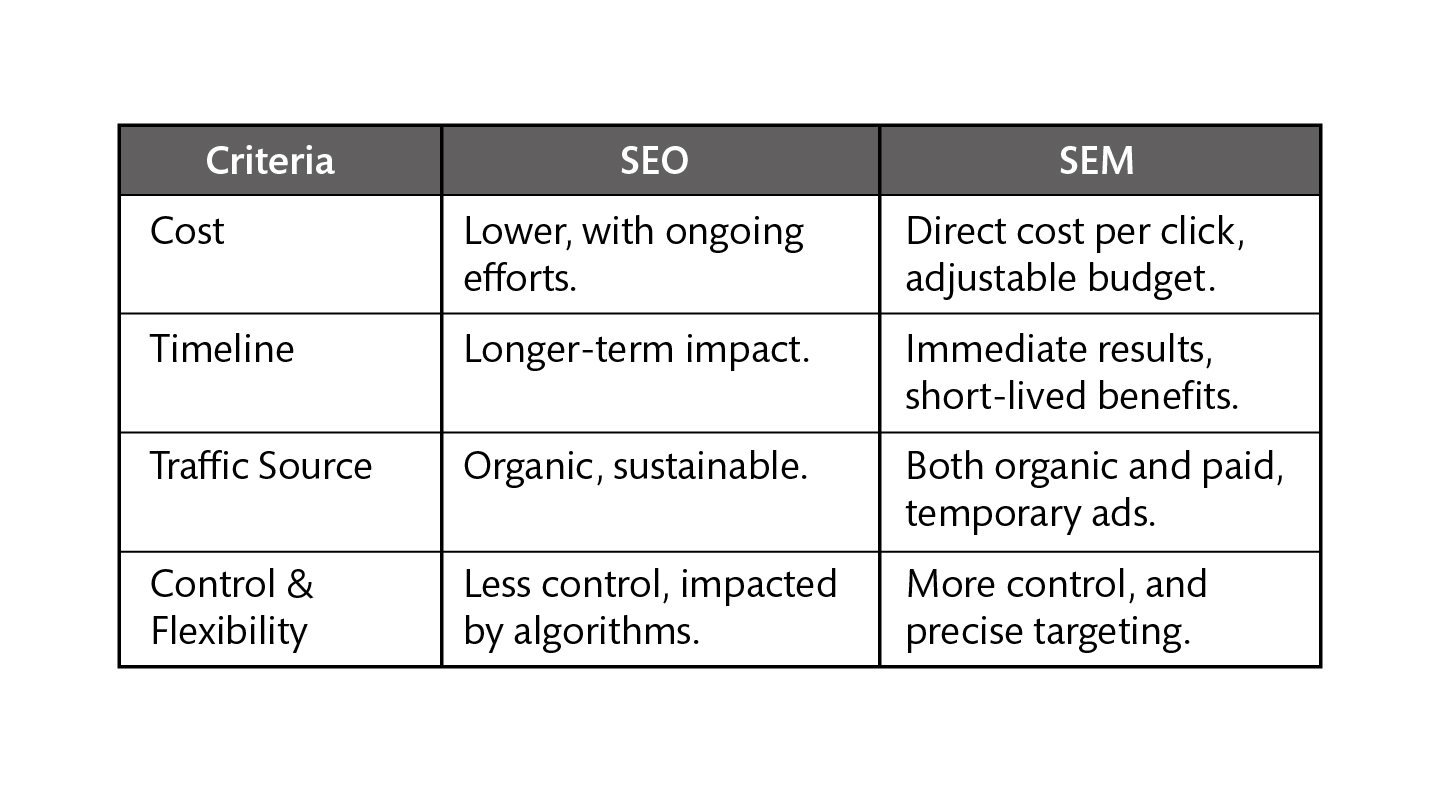Let's Talk
We would love to hear from you. Want to know more about our services or have any questions? Say Hi!
Difference Between SEO and SEM in Digital Marketing

As the world has evolved and information is now available on the click of a button, the race to be the first in the competition has also evolved. Being in the digital space or even while surfing the internet, you might have come across the terms SEO and SEM.
Search Engine Optimization (SEO) and Search Engine Marketing (SEM) are integral components of any successful online strategy. However, despite their shared objective of improving a website’s visibility on Search Engine Results Pages (SERPs), they operate in distinct ways. In this blog, we’ll delve into the nuances of SEO and SEM, unraveling their differences and highlighting when each should take the center stage in your digital marketing playbook.
Understanding SEO
Search Engine Optimization, or SEO, is a long-term strategy focused on enhancing a website’s organic (non-paid) visibility on search engines. The primary objective of SEO for the business is to rank higher in the organic search results for relevant queries. SEO involves a myriad of tactics, both on-page and off-page, to optimize a website and its content for search engines.
On-Page SEO
On-page SEO revolves around optimizing individual web pages to rank higher and earn more relevant traffic. This includes optimizing meta titles, meta descriptions, heading tags, and incorporating relevant keywords strategically throughout the content. Additionally, on-page SEO emphasizes the importance of creating high-quality, valuable content that meets the needs of users.
Off-Page SEO
Off-page SEO involves activities outside the confines of the website itself. This includes building high-quality backlinks from reputable websites, establishing a strong social media presence, and cultivating a positive online reputation. Off-page SEO signals contribute to a website’s authority and influence its rankings on search engines.
Technical SEO
Technical SEO focuses on optimizing the technical aspects of a website to improve its crawlability and indexation by search engines. This includes optimizing site speed, mobile responsiveness, fixing crawl errors, and implementing structured data markup. Technical SEO ensures that search engines can effectively interpret and rank a website’s content.
Understanding SEM
Search Engine Marketing, or SEM, is a broader term that encompasses various strategies to increase a website’s visibility in search engine results. While SEO is a subset of SEM, SEM also includes paid advertising methods like Pay-Per-Click (PPC) campaigns. The primary objective of SEM is to drive targeted traffic to a website through both organic and paid means.
PPC Advertising
PPC advertising is a core component of SEM, allowing advertisers to bid on keywords relevant to their business. When users search for these keywords, the ads appear at the top of the search results. Advertisers pay a fee only when users click on their ads, making it a cost-effective way to drive targeted traffic. Google Ads is the most popular PPC advertising platform.
SEO vs. SEM: A Comprehensive Exploration
Cost
SEO
Search Engine Optimization (SEO) involves a multifaceted approach to optimizing a website’s content, structure, and authority. The cost of implementing SEO is often lower compared to SEM, primarily because it doesn’t require direct payments for clicks. However, it’s crucial to recognize that SEO is an ongoing investment that requires consistent effort. The expenses are primarily associated with hiring skilled professionals or agencies to conduct keyword research, optimize content, and manage the technical aspects of a website. The results of SEO efforts, though impactful, may take time to materialize, and the ongoing nature of the process means that long-term commitment is essential for maintaining and improving search engine rankings.
SEM
In contrast, Search Engine Marketing (SEM) involves paid advertising to increase a website’s visibility on search engine results pages. The cost structure of SEM is based on a pay-per-click (PPC) model, where advertisers pay a fee each time a user clicks on their ad. This model offers flexibility, as advertisers can set daily or monthly budgets and adjust them based on performance. While SEM can provide immediate results, it is important to note that once the advertising budget is exhausted, the visibility diminishes. Therefore, SEM is often viewed as a more short-term and scalable solution with associated direct costs.
Timeline
SEO
The timeline for SEO is characterized by a longer-term perspective. Search engines, such as Google, employ complex algorithms to crawl, index, and rank web pages. Achieving optimal rankings requires time as search engines need to recognize and reward the relevance and quality of the optimized content. While the results of SEO efforts may not be immediately evident, the impact can be profound and lasting. The accumulation of organic traffic over time contributes to sustained visibility and credibility in the eyes of both search engines and users.
SEM
SEM, on the other hand, is renowned for its ability to deliver more immediate results. Advertisers can create campaigns and have their ads displayed prominently in search results almost instantaneously. This makes SEM an ideal choice for businesses seeking quick visibility, especially during product launches, promotions, or time-sensitive events. However, it’s important to note that the benefits of SEM are contingent on the ongoing investment in advertising, and the visibility diminishes once the allocated budget is depleted.
Traffic Source
SEO
SEO primarily focuses on organic traffic, which refers to visitors finding a website through unpaid search results. The strength of organic traffic lies in its sustainability and authenticity. Users are more likely to trust and engage with websites that appear in organic search results, as these results are perceived as earned rather than paid for. Organic traffic is a reflection of a website’s relevance and authority in the eyes of search engines.
SEM
SEM involves a dual approach, encompassing both organic and paid traffic. While the immediate impact is derived from paid advertisements, there is also an opportunity to generate organic traffic through the optimization of ad campaigns. Even after the paid campaign ends, the potential for ongoing organic traffic persists. This dual benefit makes SEM a versatile strategy for businesses aiming to capitalize on both immediate and sustained visibility.
Control and Flexibility
SEO
Search Engine Optimization provides less direct control over when and how a website appears in search results. Search engine algorithms are continually evolving, and changes can impact a website’s rankings. SEO professionals work to align their strategies with best practices, but the dynamic nature of search algorithms means that adjustments may take time to manifest results.
SEM
Search Engine Marketing, in contrast, offers advertisers a higher degree of control and flexibility. Advertisers can precisely target their audience based on factors such as demographics, location, and user behavior. Additionally, SEM platforms allow for ad scheduling, enabling businesses to control when their ads are displayed. Budget management is also highly flexible, allowing advertisers to adjust spending based on real-time performance data. This level of control makes SEM an attractive option for businesses seeking immediate and measurable results from their digital marketing efforts.
SEO vs. SEM Comparison Table

All Said And Done
In the grand scheme of digital marketing, both SEO and SEM play crucial roles, each with its unique set of advantages. The decision to prioritize one over the other depends on the specific goals, timeline, and budget of a business.
For long-term sustainability and building a strong online presence, investing in SEO is paramount. On the other hand, if immediate results and a controlled budget are essential, SEM, particularly PPC advertising, can be a valuable addition to the marketing strategy.
Ultimately, a holistic approach that integrates both SEO and SEM can yield the most comprehensive results. Striking the right balance between organic and paid strategies ensures a robust digital presence, driving targeted traffic and maximizing the online potential of any business.
Why Choose Litmus for Digital Marketing?
Litmus Branding has been in the marketing field for more than 2 decades. We do thorough research and involve 360 degree marketing making sure that your business stands tall against all, and gets the recognition it deserves.


